Eu Tong Sen and His Business Empire 余东旋与他的商业帝国
The Koh Seow Chuan Collection at the National Library includes documents from the illustrious businessman Eu Tong Sen. Seow Peck Ngiam describes some of its highlights.
国家图书馆许少全特藏包括了著 名商业巨甲余东旋文献。萧碧莹介绍了当中的一些亮点。
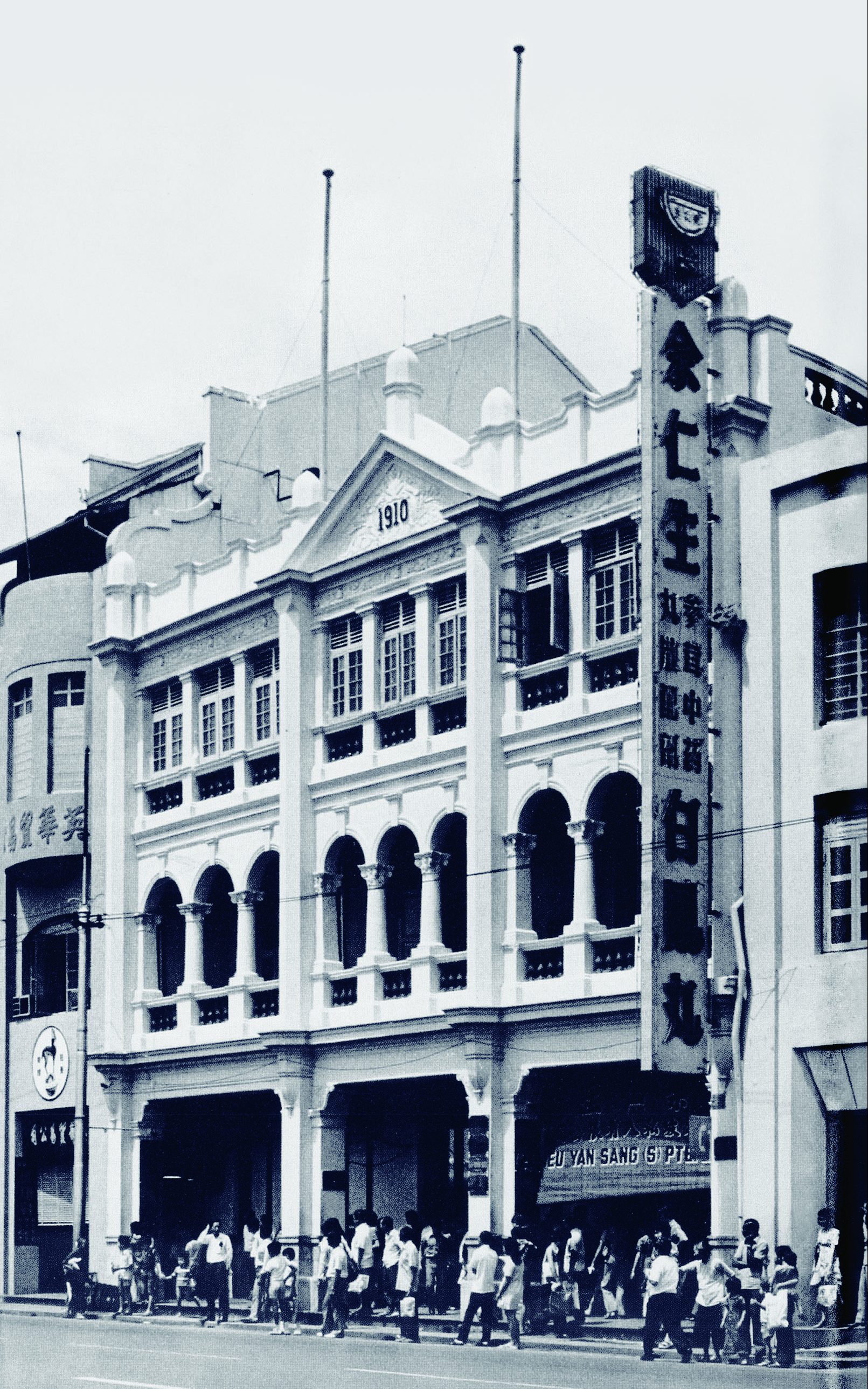 The Eu Yan Sang building along South Bridge Road houses the company’s headquarters. The first shop in Singapore on the ground floor of the building was opened by Eu Tong Sen in 1910. (位于桥南路的余仁生总部。设在一楼的新加坡首家店铺由余东旋于1910年开幕。) All rights reserved, Sharp, I. (2009). Path of the Righteous Crane: The Life and Legacy of Eu Tong Sen. Singapore: Landmark Books Pte Ltd.
The Eu Yan Sang building along South Bridge Road houses the company’s headquarters. The first shop in Singapore on the ground floor of the building was opened by Eu Tong Sen in 1910. (位于桥南路的余仁生总部。设在一楼的新加坡首家店铺由余东旋于1910年开幕。) All rights reserved, Sharp, I. (2009). Path of the Righteous Crane: The Life and Legacy of Eu Tong Sen. Singapore: Landmark Books Pte Ltd.Eu Yang Sang is a well-respected company that specialises in the manufacture and retail of traditional Chinese herbs and medicine. The company has an extensive network of outlets in Australia, China, Hong Kong, Macau, Malaysia and Singapore.1
The company has a history that stretches back to 1879 when its founder Eu Kong (also known as Eu Kwong Pai) established the first Eu Yan Sang shop in Gopeng, Perak. Just six years earlier in 1873, Eu had left his ancestral hometown of Foshan in Guangdong for Penang. After his textile dyeing and bakery businesses failed, Eu worked for a while as a debt collector for a grocery shop. In 1877, the family moved to Gopeng after the birth of his first son Eu Tong Sen.2
The first milestone was laid when Eu Kong opened the Yan Sang Medicine Shop (which means “caring for mankind” in Chinese) in Gopeng, selling traditional Chinese medicine to Chinese tin mine workers who were addicted to opium.3
In 1898, a new chapter began when Eu Tong Sen inherited his father’s business, which by then included tin mining as well as remittance and postal services. Under his leadership, the Chinese medicine business was expanded and renamed Eu Yan Sang to capitalise on the family name.4
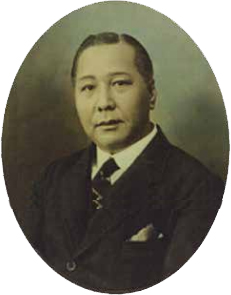 Eu Tong Sen in a portrait taken when he was in his 50s. (50余岁的余东旋肖像。) All rights reserved, Sharp, I. (2009). Path of the Righteous Crane: The Life and Legacy of Eu Tong Sen. Singapore: Landmark Books Pte Ltd.
Eu Tong Sen in a portrait taken when he was in his 50s. (50余岁的余东旋肖像。) All rights reserved, Sharp, I. (2009). Path of the Righteous Crane: The Life and Legacy of Eu Tong Sen. Singapore: Landmark Books Pte Ltd.Eu, who by then was known as the “King of Tin”, employed thousands of Chinese migrants in his tin mines, rubber estates, traditional medicine shops and property holdings.5 Many of his properties still stand in Singapore today and some have become landmarks, such as The Majestic6 (formerly Tien Yien Moi Toi, a venue for Cantonese opera) and the Yue Hwa Chinese Products building7 (formerly Nam Tin or Great Southern Hotel), both along Eu Tong Sen Street (see text box below). Eu’s remittance business – which also came under the Eu Yan Sang company – served the overseas Chinese communities in Singapore and Malaya. The company flourished, and by the end of 1920s, was recognised as one of the biggest remittance agencies in Southeast Asia.8
余仁生是新加坡一家经营传统中医药的公司, 其业务遍布新马、中港澳及澳洲地区。
余仁生的历史可追溯至1879年,创始人余广(也称余广培) 在务边霹雳州开设了的第一家余仁生中药杂货铺。在这之前, 即1873年,余广从广东佛山祖家南下,飘洋过海来到了槟城创业。经历了布匹与面包店生意失败的挫折后,余广便在杂货店打工,负责收账的工作。1877年,随着长子余东旋的诞生后,余家便迁居至务边霹雳州。余广随后在霹雳州开设了第一家仁生中药杂货铺(译指“ 仁泽众生”),售卖中药给深受鸦片毒害的华侨矿工,奠下了生意的第一座旅程碑。
1898年,余东旋继承家业,掀开了新的篇章。家业遗产当时不仅包括了中药生意,还有锡矿及汇款生意。在余的掌托下,家族生意得到了拓展并且改名为“余仁生”以突显其家族品牌。
这时的余东旋,已是众所周知的锡矿大王,名下的锡矿场、橡胶园、中药杂货铺、汇款生意和物业都有数千华侨工人为他打工。其产业很多仍然屹立至今,有些也成了本地的地标,如两栋耸立在余东旋街上的“大华戏院”(前“天演舞台”,专门上演广东戏曲),和“裕华国货”(前“南天大酒店”)。当时的余仁生公司旗下的汇款生意蒸蒸日上,为广大的马来亚和海峡殖民地的海外华侨服务。到了1920年代末,公司已成为东南亚其中最大的汇款代理商。
The Koh Seow Chuan Collection
The National Library of Singapore has a collection of documents related to Eu Tong Sen and his company Eu Yan Sang. Donated by the architect and philanthropist Koh Seow Chuan, the collection includes payment acknowledgements, receipts, invoices, remittance notes, delivery notes, bills, notices and business correspondences dating from the early 20th century and issued by Eu Yan Sang branches in Singapore and Malaysia. There are also personal receipts and correspondences relating to Eu Tong Sen and his households in the collection.
The collection provides a glimpse into the history of prominent Chinese businessmen and serve as important primary sources in the study of Southeast Asian economic history, particularly the remittance industry and the economic relations between China and Southeast Asia in the 19th and early 20th centuries. Additionally, the documents also shed light on the social history of the Chinese diaspora in Southeast Asia and Singapore.
Here are some highlights of the collection.
许少全特藏
新加坡国家图书馆有一批有关余东旋及余仁生公司的文献,它们是由本地建筑师与慈善家许少全所捐赠,主要包括二十世纪初,由余仁生新加坡及马来西亚分行所签发的凭信单、收据、货单、汇款单、通知函和商业来往文书。除此之外,文件中还有一些有关余东旋及家庭的帐单及信函。
这批文献将帮助人们从中了解早期华商的创业史。同时,这批珍贵的文献资料对研究东南亚与新加坡华侨社会史、19至20世纪初的侨批业以及中国与东南亚的经济关系史方面有着重要的参考价值。
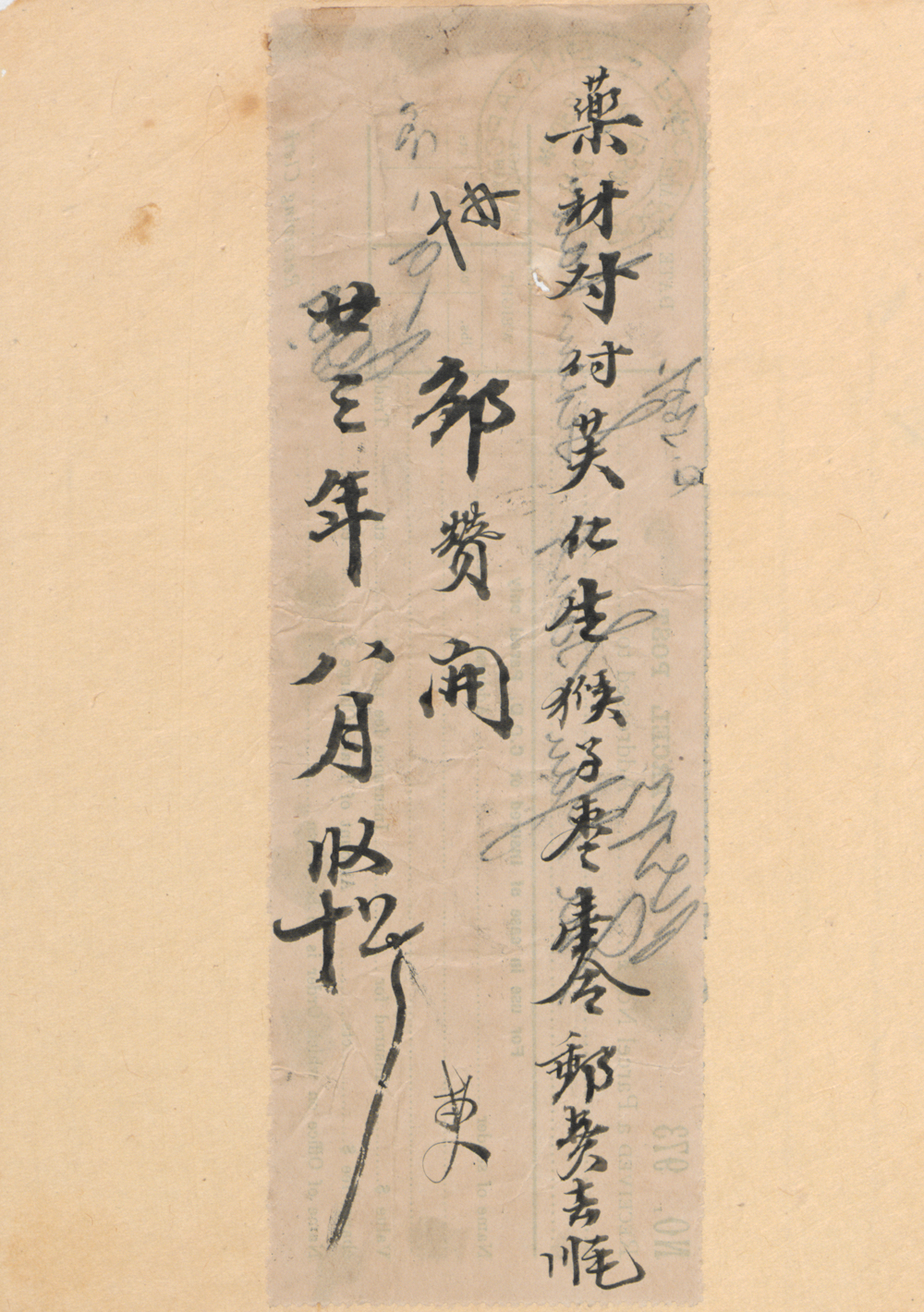 |
| 1. A postal receipt dated 24 August 1934 for Chinese red dates delivered to the Eu Yan Sang shop in Negeri Sembilan in Malaysia. The first Eu Yan Sang shop was set up in 1879 in Gopeng, Perak, selling Chinese medicine to tin mine workers addicted to opium. Over the years, Eu Yan Sang was able to make a name for itself in traditional Chinese medicine by sourcing for the best raw ingredients and producing only high quality products. |
| 这是一张1934年8月24日年寄往马来西亚芙蓉县(森美兰州)余仁生分行的邮递品收据,物品是猴 子枣。第一间余仁生中药铺在1879年务边霹雳州创立,售卖中药给深受鸦片毒害的华侨矿工。多年 来,余仁生能够在中药业打响招牌,凭着的就是对中草药采购的严谨,以制作出上等品质的货品。 |
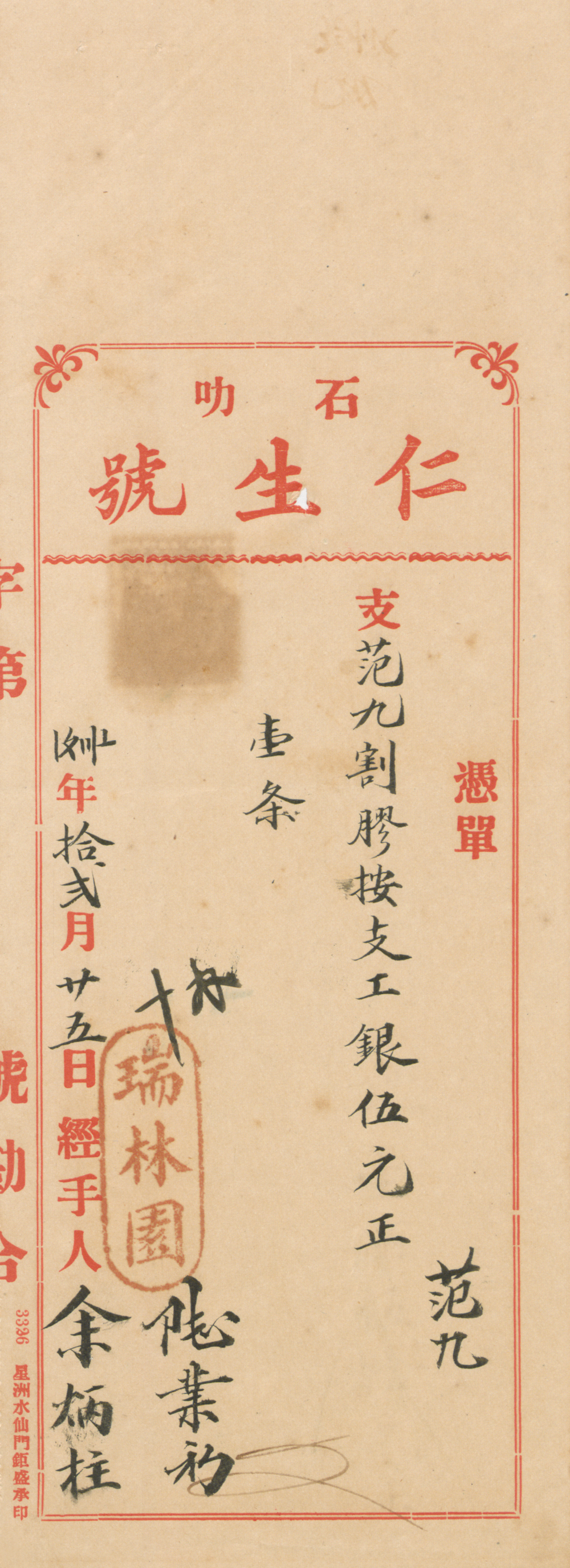 |
| 2. Issued on 25 December 1936, this invoice from the Eu Yan Sang branch in Singapore was for a salary payment of five Straits dollars and has the words “Swee Lam estate” stamped on it. Eu Tong Sen owned some 15,000 acres of rubber plantations across Malaya. Seven rubber plantations, including Swee Lam estate in Johor, were managed by the Eu Yan Sang branch in Singapore. Interestingly, Eu named the plantations after his wives, daughters and other female relatives and friends.9 |
| 这张凭单发于1936年12月25日,作为支付给范九工银叻币五元的凭据。凭单印有胶园“瑞林园”书柬。余东旋拥有一万五英亩树胶园,遍布马来亚。新加坡余仁生负责管理7个树胶园,包括柔佛瑞林园。有趣的是,余东旋的树胶园都是以妻子、女儿及其他女性亲朋戚友命名的。 |
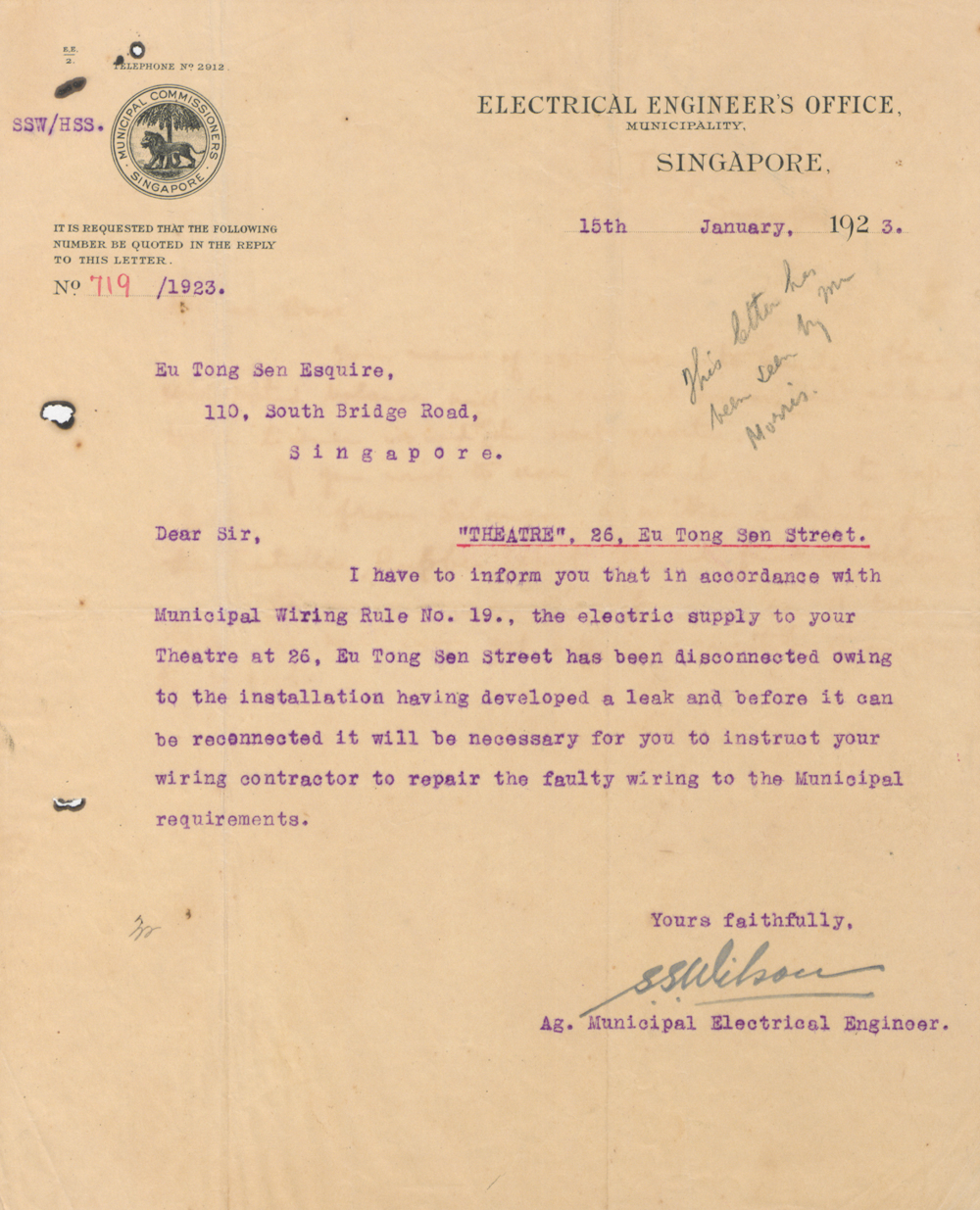 |
| 3. This letter from the Electrical Engineer’s Office of the Municipal Commissioners of Singapore informed Eu Tong Sen on 15 January 1923 that the power supply to a theatre at 26 Eu Tong Sen Street had been disconnected and would be reinstated only after maintenance works had been carried out. [Note: the name of the theatre cannot be ascertained but it was possibly the Heng Wai Sun or the Heng Seng Peng, see text box below.] |
| 此信函是市镇局于1923年1月15日通知余东旋位于余东旋街26号的戏院因事故电源已被割断,有待维修工作完成后才能重新启动。[注:戏院名称无法被确定,但有可能是庆维新或庆升平。] |
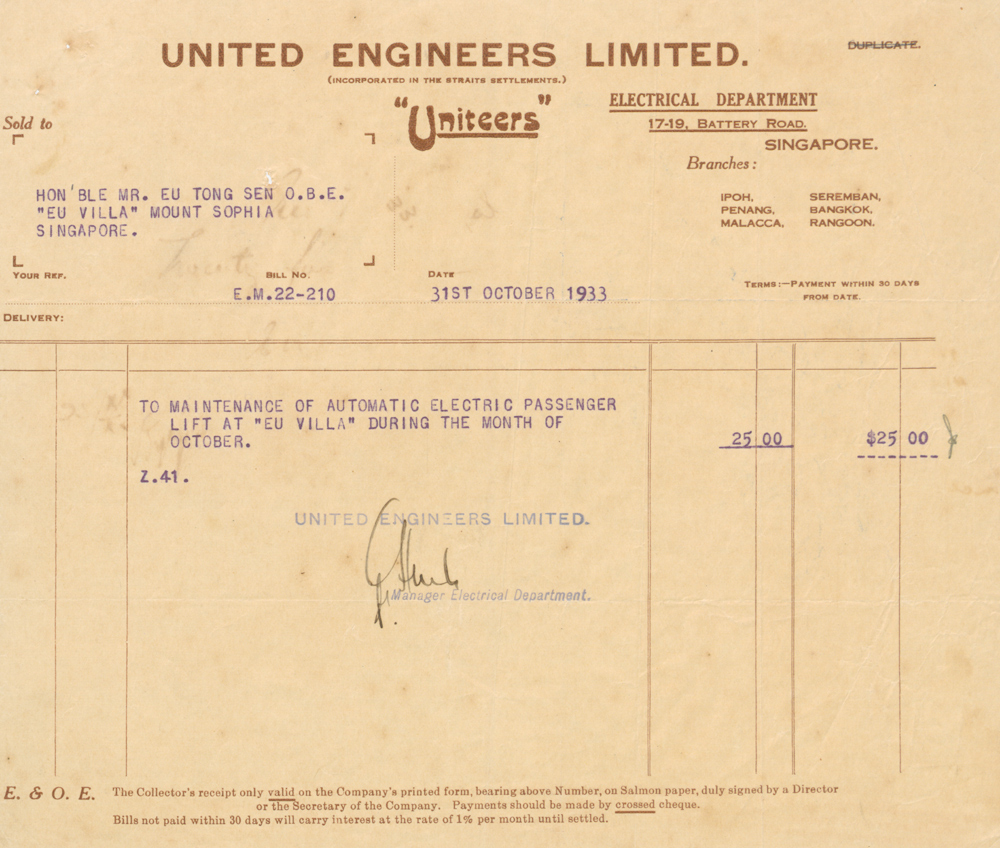 |
| 4. A bill from United Engineers Limited dated 31 October 1933 for the maintenance fee of $25 for an electric lift in Eu Villa. Among the many properties owned by Eu Tong Sen in Singapore, the most well-known was perhaps Eu Villa at Adis Road on Mount Sophia. It was designed by Swan & Maclaren in 1914. The lift was specially installed for Eu’s mother to take her to the top floor to enjoy the scenery. Eu Villa was demolished in the 1980s to make way for a condominium.10 |
| 这是United Engineers Limited于1933年10月31日在余园维修电梯的账单,费用为25元。在不计其数的产业中,位于苏菲雅山亚迪斯路,由双麦嘉仁建筑公司于1914年设计的余园也许是最广为人知。电梯是余东旋为能让母亲到顶楼看风景而设。余园在80年代已因公寓发展而被拆除。 |
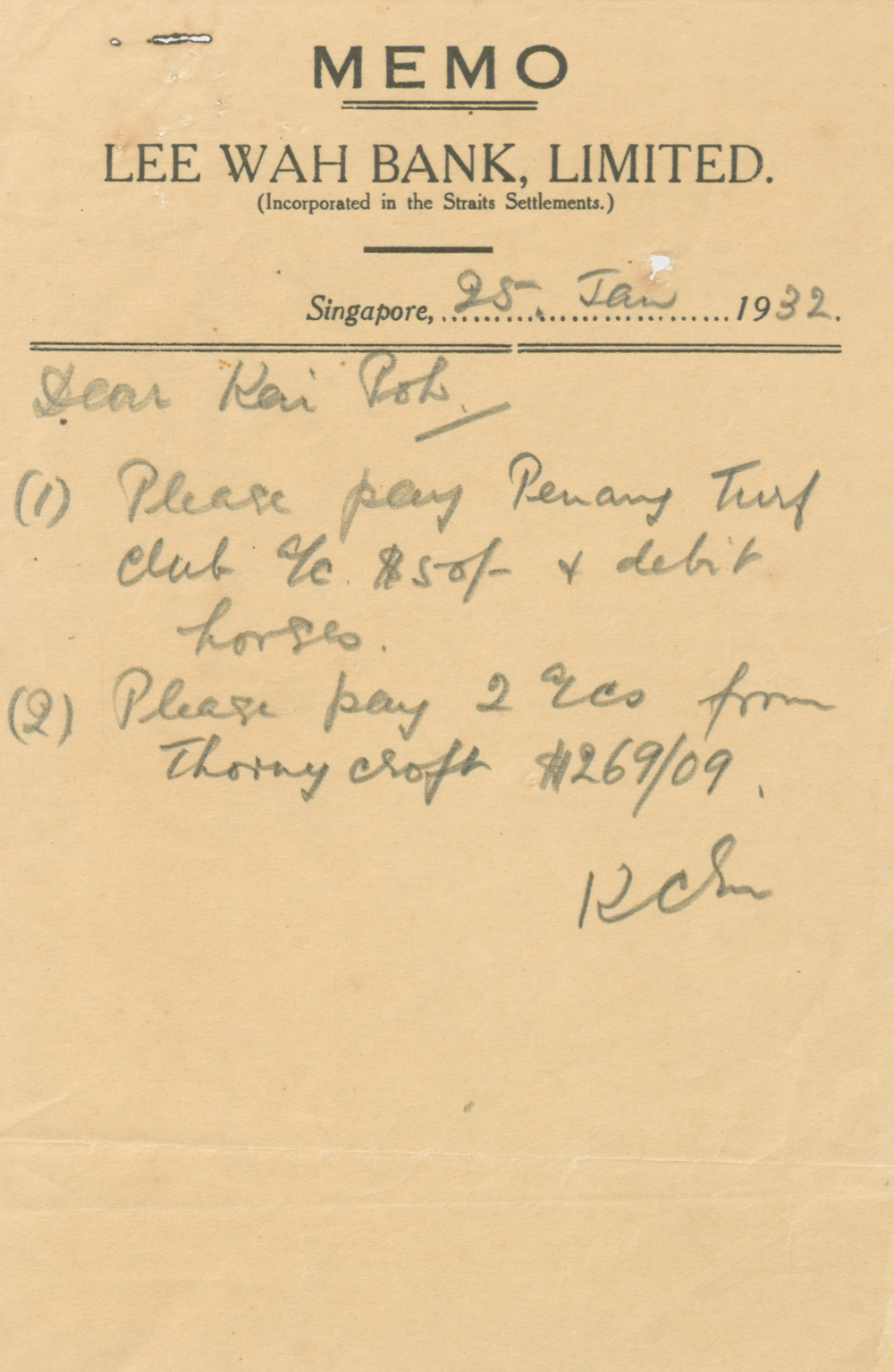 |
| 5. An account memo with two payment instructions, one of which was to the Penang Turf Club, issued by Eu Keng Chee (or K. C. Eu), Eu Tong Sen’s eldest son, on 25 January 1932 in his capacity as Managing Director of Lee Wah Bank. Founded in 1920 by a group of businessmen led by Eu Tong Sen, who became its first Chairman, the bank specifically served the Cantonese community (all staff members were required to converse in Cantonese). The bank managed to weather the Great Depression years and World War II, but a series of setbacks in the late 1960s resulted in its acquisition by United Overseas Bank in 1973.11 |
| 这是一张余东旋长子余经铸在出任利华银行董事经理时,有关两项支付账目的指示便笺。日期是1932年1月25日,其中一项是槟城赛马会的款项。由粤商集资,余东旋带领,创立于1920年的利华银行,专门接待粤籍顾客(员工必须能够说粤语)。银行虽然在世界大萧条和二战的艰难时期仍然能度过,但60年代末的几次严重挫折最终使得银行于1973年被大华银行收购。 |
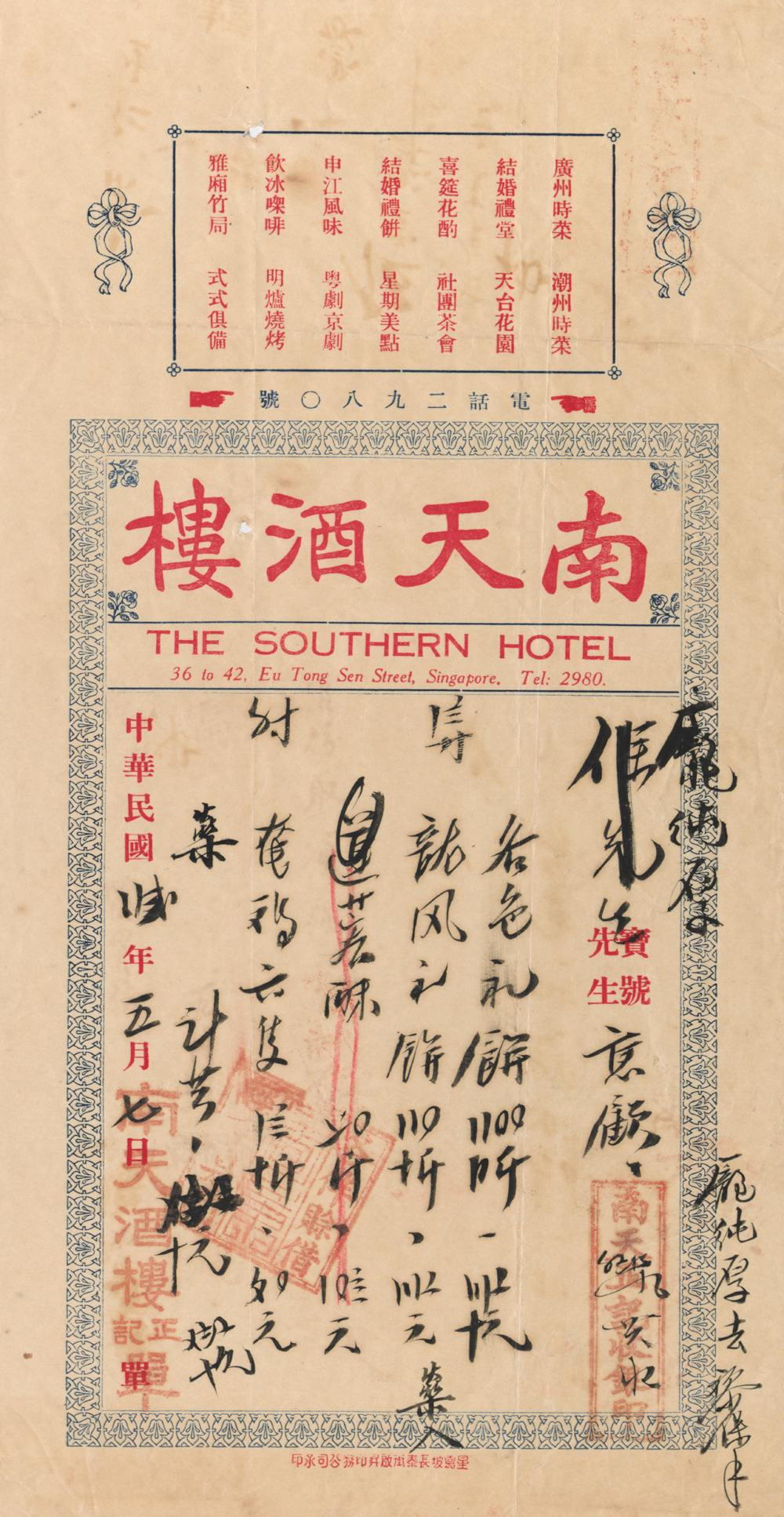 |
| 6. A 7 May 1933 invoice from the Great Southern Restaurant – which was located in Nam Tin or Great Southern Hotel on Eu Tong Sen Street – for the sale of Chinese pastries. Erected in 1927, the building was patronised by the wealthy and the literary class during its halcyon years before World War II.12 The hotel on the second and third floors was the first Chinese lodgings equipped with an elevator.13 After the war, the fifth floor was converted into a nightclub called Diamond Dragon Dance Palace.14 |
| 此单是位于余东旋街上,南天大酒店内的南天酒楼糕点账单,日期为1933年5月7日。南天大酒店始于1927 年,在战前时的鼎盛时期,这里可说是达官贵人、名人雅士的聚集之地。二楼及三楼的酒店设施,是第一间有电梯服务的华人酒店。战后,五楼改为龙宫大舞厅。 |
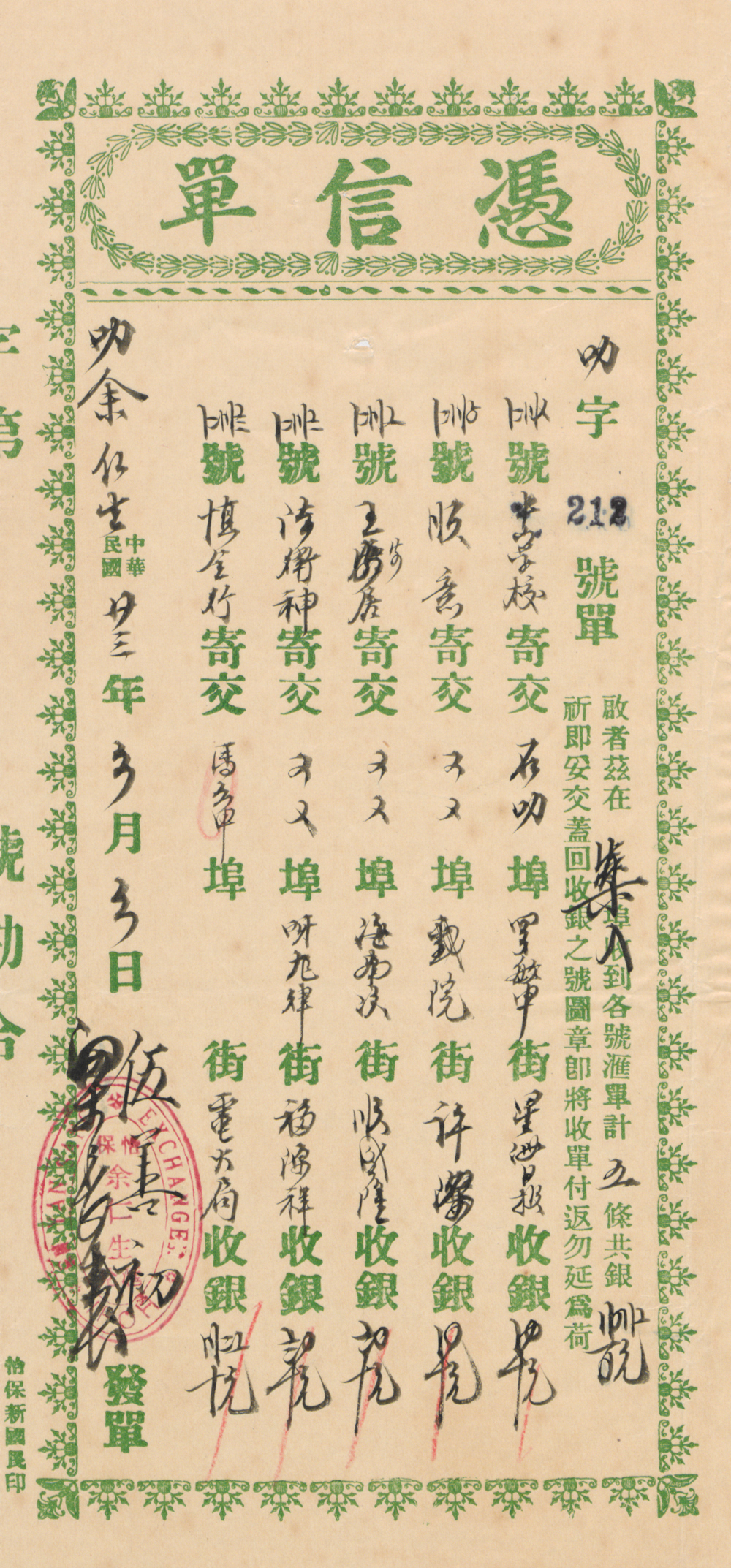 |
| 7. Dated 6 June 1934, this is a remittance note sent from the Eu Yan Sang branch in Ipoh to its counterpart in Singapore. Direct remittances between the two places were regularly carried out. The Singapore branch was divided into three units: remittance, wholesale Chinese herbs and pharmaceutical retail. Its remittance business was the most profitable.15 |
| 这是怡保余仁生于1934年6月6日转发给新加坡余仁生的汇款凭信单。当年两地可作直接汇款。从前新加坡的“余仁生”的店面划分为三个区,汇兑部、生药材批发部和药品零售部。其中,汇款生意最为兴旺。 |
 |
| 8. Eu Tong Sen was one of two Chinese representatives in Perak who sat in the powerful Federated Malay States (FMS) Chamber of Mines, which was controlled by the Kinta miners. This letter dated 31 October 1921 from the government of the FMS informed Eu that the legislation on “the subject of section 18 (ii) of the Mining Enactment no. xii of 1911” would be introduced in the next Federal Council meeting in November 1921.16 |
| 余东旋是四州府矿务局的两位华侨代表之一。矿务局拥有极大势力,由近打谷锡矿商操控着。由四州府政府发出的这封信函,日期为1921年10月31日,主要告知余东旋有关在1911年立法的锡矿开采业法律中的第18(ii)条文将会在11月份的议政局会议提出讨论。 |
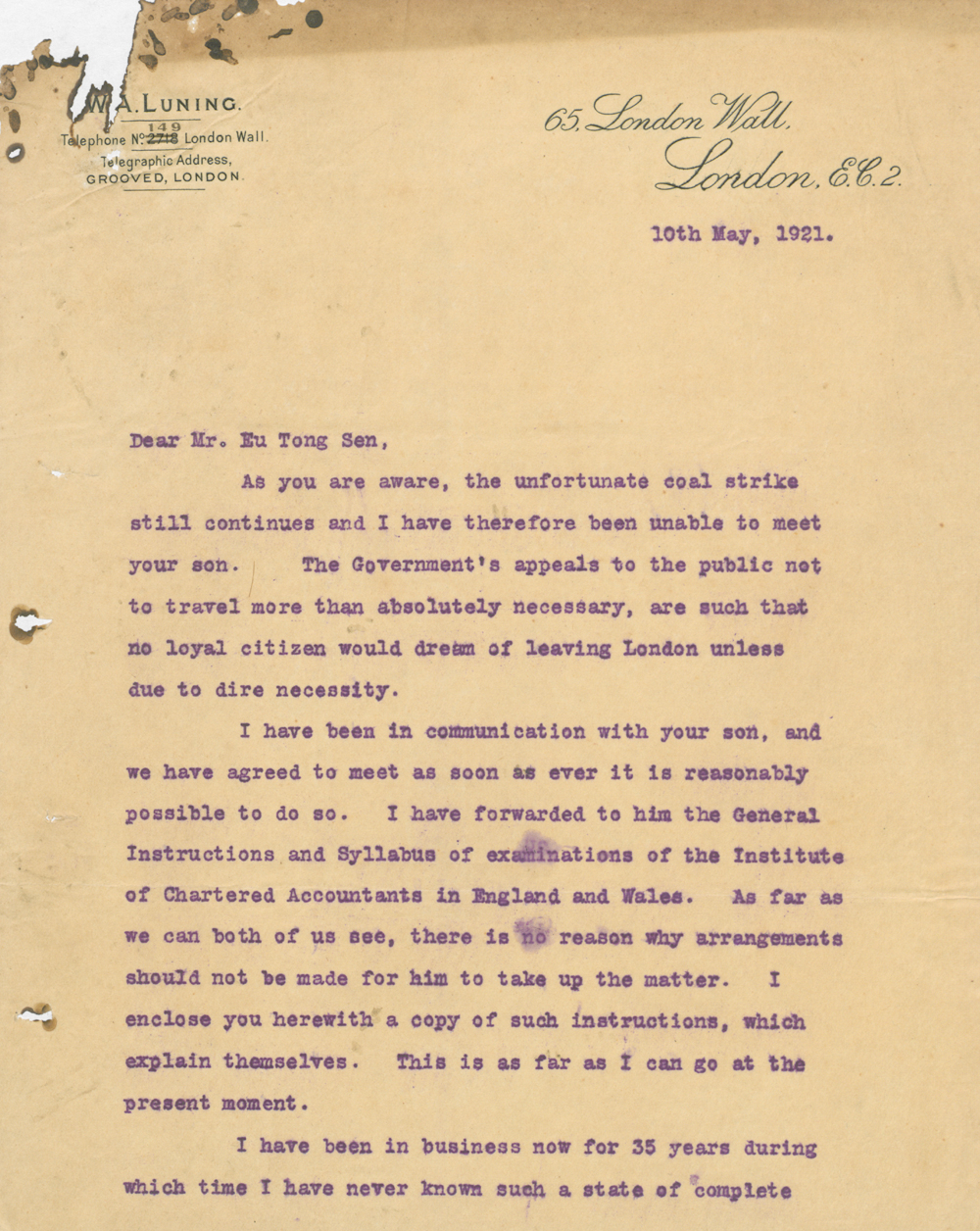 |
| 9. This letter in English, which shows the first of three pages and dated 10 May 1921, was written by William Antrobus Luning (the former Chairman of Kinta Tin Mines Ltd) in London. It was addressed to Eu Tong Sen in Singapore. Eu had entrusted Luning as the guardian of his eldest son, Eu Keng Chee (K. C. Eu), during his studies in the UK. Luning wrote that he had given the young man information about the accountancy course at Cambridge University. Upon graduation in 1925, K. C. Eu returned to Malaya and became the first certified public accountant in Singapore. After Eu passed on, K.C. Eu and his brothers inherited the family business.17 |
| 这是 William Antrobus Luning(前近打锡业有限公司主席)从英国邮寄至新加坡,给余东旋的一封英文信函中的第一页。余东旋曾托付他为监护人,以代为照顾在英国留学的长子余经铸。信中Luning 提及他已把相关报读英国剑桥大学会计课程的资料交给余经铸。余经铸1925年学成归来马来亚,成为新加坡第一位注册会计师。余东旋过世后,他与兄弟继承遗产,成为家族生意的掌舵人。 |
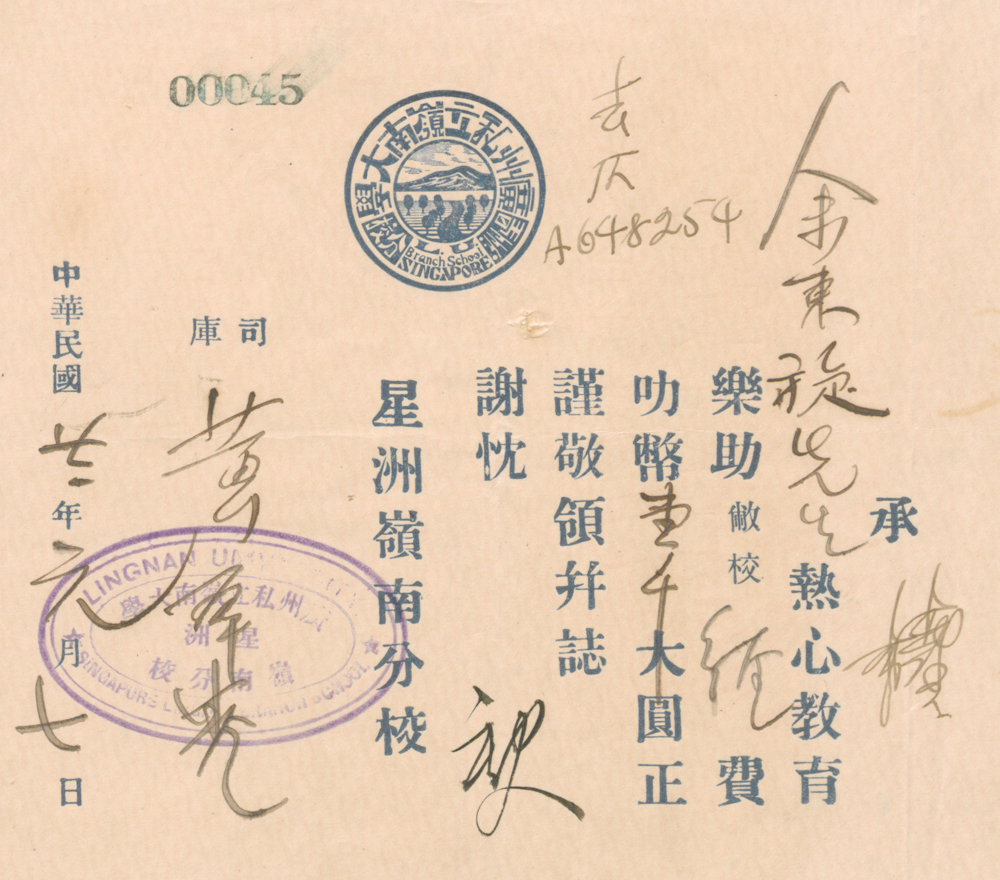 |
| 10. Eu Tong Sen was widely known for his acts of philanthropy. This acknowledgement receipt issued on 7 January 1933 was for his donation of 1,000 Straits dollars to Lingnan School, which was affiliated to Lingnan University in Guangdong, China. Eu was one of the founders of the school that was established in 1931 to provide Chinese education to the Chinese communities in Southeast Asia.18 |
| 众所周知,余东旋也是名慈善家,对慈善事业一向不遗余力。这是他于1933年1月7日惠娟一千叻币给星洲岭南分校的收条。学校是广东岭南大学的新加坡分校,余东旋是发起人之一,宗旨是为东南亚的华侨提供华文教育。 |
THE STREET NAMED AFTER EU
There are two versions as to how Eu Tong Sen Street got its name. The obvious explanation is that the street was renamed after Eu in recognition of his contributions to the community. According to the more intriguing story, one of the troupe leaders of an opera theatre at the long-gone Wayang Street had offended Eu’s eighth wife, Wong Sui Chun. In a fit of anger, Eu bought up all the properties along Wayang Street and renamed the street after himself.19 Among the acquired properties were the two oldest and most renowned local opera theatres, Heng Wai Sun and Heng Seng Peng. Both specialised in Cantonese opera although the latter also staged Hokkien and Peking opera. In 1928, Eu commissioned the colonial architectural firm Swan & Maclaren to build another opera theatre called Tien Yien Moi Toi along the same street. Heng Seng Peng and Heng Wai Sun theatres have since been demolished but Tien Yien Moi Toi theatre still remains today. It was renamed Majestic Theatre in 1945 after the war, and in 2003, was converted into a shopping mall known as The Majestic.20 The building is presently leased to the Singapore Turf Club and is mostly used as a betting centre.21
以余东旋为名的街道
有关余东旋街得名有二说。最普遍的说法即是为纪念余东旋对社会所付出的贡献。根据另一种较引人入胜的说法则是位于已不存在的哇央街的戏院班主得罪了其八夫人,慎怒之下把整条街的地产买下并以自己姓名为街道改名。其中被收购的地产包括新加坡最早期的地方戏戏院庆维新和庆升平。两座戏院都上演粤剧,但庆升平除了广东戏曲外,同时也上演福建与京剧。1928年,余东旋委托英殖民地建筑公司双麦嘉仁在同一条街上兴建另一所戏院,即“天演大舞台”。庆维新和庆升平随着时代的变迁而被拆除,但“天演大舞台”则依然岂立至今。战后1945年改名为“大华戏院”并在2003年被发展成购物商场,改名 “The Majestic”。大厦如今由新加坡赛马公会租用,主要作为投注中心用途。
 Seow Peck Ngiam is a Senior Librarian at the National Library, Singapore. Her responsibilities include the selection of Chinese materials and donor collections for the library as well as the provision of reference and information services. The Chinese translation was edited by Vicky Gao, a Senior Librarian who specialises in China Studies at the National Library, Singapore.
Seow Peck Ngiam is a Senior Librarian at the National Library, Singapore. Her responsibilities include the selection of Chinese materials and donor collections for the library as well as the provision of reference and information services. The Chinese translation was edited by Vicky Gao, a Senior Librarian who specialises in China Studies at the National Library, Singapore.
萧碧莹是新加坡国家图书馆的高级图书馆员。负责范围包括华文馆藏采选、捐赠馆藏及为读者提供咨询服务。华文翻译由高小行编辑。她是国家图书馆高级参考馆员,中文学科馆员。
NOTES
-
Eu Yang San. (2015). Our business. Retrieved from Eu Yang Sang website. ↩
-
Sharp, I. (2009). Path of the righteous crane: The life and legacy of Eu Tong Sen (pp.3, 9–10). Singapore: Landmark Books Pte Ltd. (Call no.: RSING 338.7616151092 SHA) ↩
-
Sharp, 2009, p. 11; Eu Yan Sang. (2015). Our history. Retrieved from Eu Yan Sang website. ↩
-
吴彦鸿 [Wu Y.H.]. (1997). 新加坡风土志 [Xinjiapo feng tu zhi] (p. 18). 新加坡 : 新加坡潮州八邑会馆文教委员会出版组. (Call no.: Chinese RSING 959.57 WYH) ↩
-
区如柏 [Qu, R.B.]. (1994, July 3). 战前最堂皇的建筑物 南天大 厦67年史 [Zhan qian zui tang huang de jian zhu wu nan tian da sha nian shi] 联合早报 [Lianhe Zaobao], p. 46. Retrieved from NewspaperSG. ↩
-
Chung, S.P.-Y. (2002, July). Surviving economic crises in Southeast Asia and Southern China: The history of the Eu Yan Sang business conglomerates in Penang, Singapore and Hong Kong. Modern Asian Studies, 36 (3), 579-617, p. 604. Retrieved from JSTOR via NLB’s eResources website; Sharp, 2009, p. 180. ↩
-
Sharp, 2009, pp. 160–161; Mr. Eu Tong Sen’s million dollar villa. (1934, September 9). The Straits Times, p. 4; Lee, Y. M. (1981, June 20). Eu Villa gives way….The New Nation, p. 12; Koh. B. (2008, February 24). Postcards from the past. The Straits Times, p. 58. Retrieved from NewspaperSG. ↩
-
大业华年 [Da ye hua nian] (pp. 69–77). (1985). 新加坡: 大华银行集团. (Call no.: Chinese RSING 332.12095957 GRO) ↩
-
区如柏 [Qu R. B.]. (1990, September 9). 昔日的香格里拉南天走过63年 [Xi ri de xianggelila nantian zou guo 63 nian]. 联合早报 [Lianhe Zaobao], p. 42. Retrieved from NewspaperSG. ↩
-
莫美颜 [Mo, M.Y.]. (1990, September 9). 南天的夜总会 [Nan tian de ye zong hui]. 联合早报 [Lianhe Zaobao], p. 42. Retrieved from NewspaperSG. ↩
-
区如柏 [Qu, R.B.]. (2013). 新加坡的广帮汇兑业 [Xinjiapo de guang bang hui dui ye]. 源 [Yuan], 5 (105), p. 10. 新加坡: 新加坡宗乡会馆联合总会 [Singapore Federation of Chinese Clan Associations]. Retrieved from Singapore Federation of Chinese Clan Associations website. ↩
-
Khoo, S.N., & Lubis, A.-R. (2005). Kinta Valley: Pioneering Malaysia’s modern development (p. 107). Ipoh: Perak Academy. (Call no. RSING q959.51 KHO) ↩
-
筹办星洲岭南分校缘起及其他 [Chou ban xing zhou lingnan fen xiao yuan qi ji qi ta]. (1931, June 2). 南洋商报 [Nanyang Siang Pau], p. 8. Retrieved from NewspaperSG. ↩
-
吴宏砚 [Wu, H.Y.]. (1987, February 8). 庆维新、庆升平、怡园、哲园… 早期地方戏戏院今何在? [Qingweixin, qingshengping, yiyuan, zhe yuan… zao qi di fang xi xi yuan jin he zai]. 联合早报 [Lianhe Zaobao], p. 26. Retrieved from NewspaperSG. ↩
-
Yen, F. (2011, November 6). Majestic theatre back in the spotlight. The Straits Times, p. 13. Retrieved from NewspaperSG. ↩

